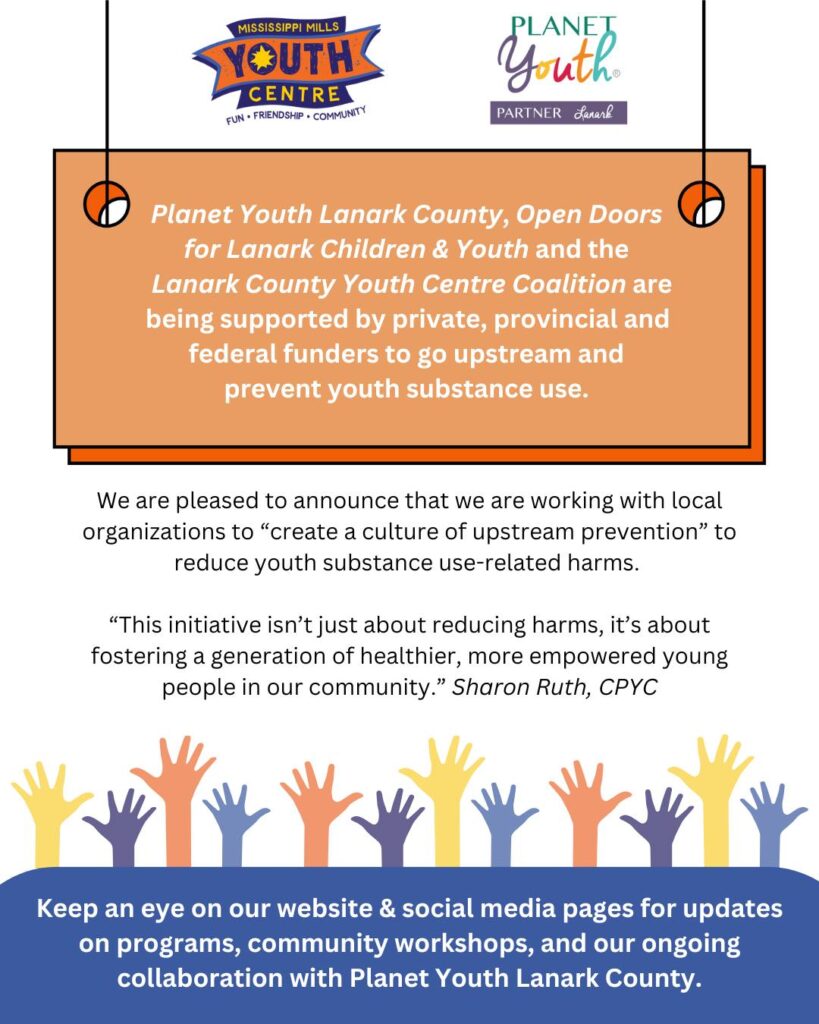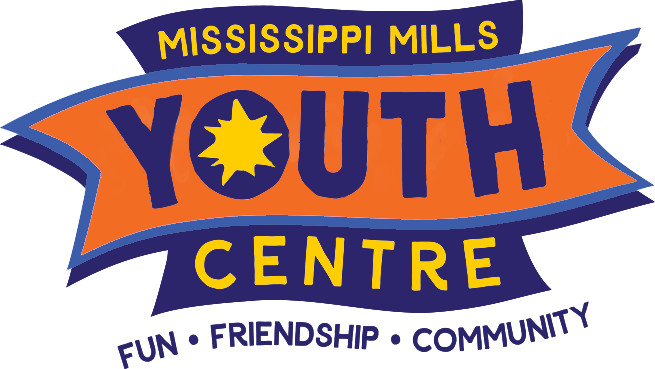Funding supports creation of “a culture of upstream prevention in Lanark County”
Planet Youth Lanark County and youth centres being supported by private, provincial and federal funders to go upstream and prevent youth substance use.
Planet Youth Lanark County (PYLC), Open Doors for Lanark Children & Youth and the Lanark County Youth Centre Coalition are pleased to announce that they are “creating a culture of upstream prevention” to reduce youth substance use-related harms. Financial support from provincial, federal and private funding sources is enabling the development and implementation of upstream prevention action plans. This strengthens ongoing collaboration with organizations like the Upper Canada District School Board and the South East Health Unit (formerly the Leeds, Grenville and Lanark District Health Unit).
“This initiative isn’t just about reducing harms,” says Sharon Ruth, Executive Director, Carleton Place Youth Center, “it’s about fostering a generation of healthier, more empowered young people in our community.”
Detailed planning is underway to share results of the 2022 and 2024, grade 10 student surveys and insights from PYLC’s youth advisory committee (ACHIEVE). Among many identified risks, insufficient youth sleep (66% sleep < 8 hours/night) is a significant risk factor in Lanark County. A partnership with the Canadian Sleep Research Consortium is supporting developing action plans to improve youth sleep health. Further detail on this initiative will be released in the near future.
A March 31 public meeting will explore opportunities for family, school and community collaboration that strengthens youth resilience. ACHIEVE will open the meeting by providing a youth perspective on priorities for this collaboration. Michael Ungar, PhD, the Canada Research Chair in Child, Family and Community Resilience will provide a keynote address at the meeting. Dr Ungar is also conducting multiple workshops on resilience on March 31 and April 1.
“We are grateful for the opportunity to partner with Lanark County’s youth centres in our upstream work to prevent youth substance use,” says David Somppi, Chair of the Planet Youth Lanark County Steering Committee. “Their leadership has already made a significant and positive impact.”
More information and survey results are available here.

What is the Icelandic Prevention Model (IPM)?
A: The Icelandic Prevention Model (IPM) is an evidence-based primary prevention approach with demonstrated effectiveness in reducing substance use in Iceland for over 25 years.
Lanark County was the first Canadian community to embrace the Icelandic Prevention Model. PYLC is now part of a growing Canadian IPM network.
Planet Youth is an analytics and consultancy organization that runs a guidance program to help communities around the world implement the IPM. The goal is to build healthy environments for positive youth development (see The Method).
In 2023 the Public Health Agency of Canada launched the Youth Substance Use Prevention Program (YSUPP) a national initiative that seeks to prevent substance use and promote wellness by supporting the implementation of the IPM within a Canadian context.
What makes the Icelandic Prevention Model different than our existing substance prevention activities?
A: The IPM requires a shift in thinking. It requires going from an individual perspective to a collective perspective, and from short-term goal setting to long-term goal setting.
The IPM focus is primordial/primary prevention, which means altering the environment to stop a behaviour from ever happening. This is different from secondary prevention (preventing further harm as youth start experimenting with substances) and tertiary prevention (helping youth not fall back into a cycle of misuse).
This model views society as the patient and focuses on enhancing the environments that surround youth, rather than focusing on individual decision-making.
The IPM is not a program, but rather a comprehensive approach where communities use local data to identify priorities and establish long-term, community-driven strategies to increase protective factors and reduce risk factors that will help to prevent and delay substance use.
Most data collection tools in Ontario and Canada do not provide timely reporting. The current data lag time is two years or more. The IPM allows reporting of local data within 6-8 weeks of collection. Analysis highlights key areas for local focus and solution building.
A local coalition of diverse community partners oversees the process and implements prevention strategies to address priorities identified through the data collected. YSUPP funding is allowing Lanark County’s five youth centres to assume leadership roles within the local coalition.
Is the IPM different or complementary to Youth Wellness Hubs Ontario?
“Youth Wellness Hubs Ontario (YWHO) is an Integrated Youth Services (IYS) initiative designed to address the service gaps in the youth mental health and substance use sectors in Ontario” Home | Youth Wellness Hubs Ontario . This initiative delivers tailored programs co-developed by youth to support individual needs. Youth Wellness Hubs are designed as a service model aimed at attracting and offering effective care and treatment to young people, including walk-in access to primary health care, peer support, employment services, etc. These are welcome services to support secondary and tertiary prevention of youth substance use.
The IPM is a multi-level approach with the core principle that “prevention activities should engage the whole population of young people rather than targeting particular individuals or groups.”
Planet Youth coalitions are groups of local partners from private and public organizations (i.e., faith-based groups, police, service clubs, youth centres) that come together to engage in community engagement, data collection at local schools, priority setting, funding identification, and information sharing of the reports. Youth Wellness Hub teams would be an example of a key partner to have within these coalitions that will benefit from the data reports and community collective action by aligning programs and activities.
It is important to offer interventions that target all levels of prevention for a comprehensive strategy to reduce substance use among youth. Further, Youth Wellness Hubs are well positioned to work synergistically with local communities in the Icelandic Prevention Model’s implementation steps 7-9: goal setting, policy and practice alignment, and prevention interventions.
Why invest in upstream prevention>
The current costs incurred from substance use in Ontario and Canada are not sustainable. In 2020, the estimated overall cost of substance use in Ontario was more than $18 billion! This amounts to ~$1,200 per person regardless of age. The costs include healthcare, lost productivity, criminal justice, and other direct costs. Investing in prevention is cost-effective and saves on treatment and other societal costs in the long run.
Benjamin Franklin’s quote of “an ounce of prevention is worth a pound of cure” highlights the wisdom of planning and investing ahead to avoid problems.
In alignment with Ontario’s Roadmap to Wellness, support from all levels of government and community actors invested in the wellbeing of youth and healthy communities is required.
We are not Iceland, why do we need people from Iceland telling us what to do?
A: We don’t adopt this model as-is — we adapt it for our local communities. Canadian communities are working together to align and support each other in adapting this model. Planet Youth Lanark County is an active contributor to this work.
Communities across Canada are embracing this model with support from the Public Health Agency of Canada YSUPP Projects – KDE Hub
No one from Iceland or anywhere else outside our communities is telling us what to do. The pioneers in Iceland have simply devised an effective survey, rapid data processing method, and step-by-step pathway to engage our communities to develop healthier futures.
